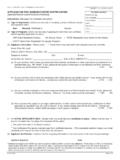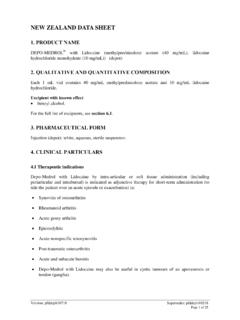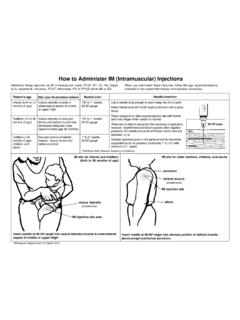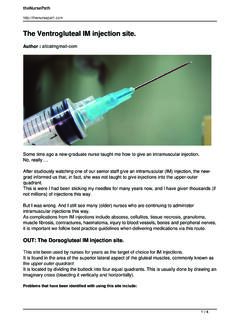Transcription of Giving a subcutaneous injection - CDSS Public Site
1 Patient Education 1 Giving a subcutaneous injection Giving a subcutaneous injection What is a subcutaneous injection ? A subcutaneous injection is given in the fatty layer of tissue just under the skin. A subcutaneous injection into the fatty layer of tissue (pinched up to give the injection ) under the skin. Why are subcutaneous injections given?These injections are given because there is little blood flow to fatty tissue, and the injected medication is generally absorbed more slowly, sometimes over 24 hours. Some medications that can be injected subcutaneously are growth hormone, insulin, epinephrine, and other substances.
2 Preparing to give medicationSubcutaneous injections are not given if the skin is burned, hardened,inflamed, swollen, or damaged by a previous injection . l. Wash your hands thoroughly. This is the best way to prevent infection. 2. Assemble your equipment: Medication May be a multidose vial of liquid or may be a vial with powder that requires reconstitution. Follow the manufacturer s instructions as to what and how much diluent to use. The diluent is usually saline (a mixture of salt water) or sterile water. Syringe or pen and needleDepending on the amount of medication to be given and the size of the child or adult: cc, cc, or 2 cc with 27 gauge needle (5/8 of an inch long) 3 cc luer lock syringe used when solution is more than 1 cc 25 gauge needle (5/8 of an inch long or 27 gauge needle (5/8 of an inch long) mL insulin syringes with 31 gauge needles (3/16 to 5/16 inches long ) are available for those who are visually impaired or for those who need very small doses of medication.)
3 Medication log container for syringe disposal sterile 2 x 2 inch gauze pad alcohol pads Drawing up medication1. Check the label for correct medication. 2. Remove the soft metal or plastic cap protecting the rubber stopper of the vial. 3. If the medication vial or pen can be used for more than one dose, record the date and time on the label. 4. Clean the exposed rubber stopper using an alcohol swab. 5. Remove the syringe from the plastic or paper cover. If necessary, attach the needle securely. 6. Pull back and forth on the plunger by grasping the plunger handle. Grasping the handle end will prevent contami nation of the plunger shaft (which is sterile).
4 7. With the needle capped, pull back the plunger, filling the syringe with air equal to the amount of medication to be administered. 8. Remove the cap covering the needle and set it on its side to prevent con tamination. Be careful not to touch the needle. The inside of the cap and needle is sterile, and the needle will be covered again with this cap. 9. With the vial in an up right position, push the needle through the cleansed rubber stopper on the vial. Push the needle in at a 90 degree angle, being careful not to bend the needle. the air in the syringe into the vial. Air is injected into a multi dose vial to prevent a vacuum from forming.
5 If too little or no air is injected, withdrawing the medication may be difficult. If too much air is injected, the plunger may be forced out of the barrel causing the medication to spill. the vial upside down, with the needle remaining in the vial. The needle will be pointing upward. sure that the tip of the needle is completely covered by the medication. This will make it easier to withdraw the solution (and not air). back on the plunger to fill the syringe with the correct dose of medication. the vial upside down, with the needle in the vial pointed upward. Tap the syringe, or flick it with your fingertips.
6 This helps move bubbles to the top of the syringe. the bubbles are at the top of the syringe, gently push on the plunger to force the bubbles out of the syringe and back into the vial. Or, you may push all the medication solution back into the vial, withdraw again slowly, and repeat steps 14 and 15. Note: It is important to eliminate large air bubbles because they take up space needed for the medication, and they may cause pain or discomfort when injected. removing the bubbles, check the dose of medication in the syringe to be sure you have drawn up the cor rect amount. If using a pen, skip steps 5 to 16.
7 Do the following: a. Attach needle to pen by cleaning the top with alcohol and screwing on the needle. b. Dial in your prime volume (usually mL) using the manufacturer s directions.. c. With pen needle pointed up, push the injection button completely. You should see a drop or stream of liquid. If you do not, repeat priming steps until this occurs. d. Dial in prescribed dose of medication. 17. After the medication is correctly drawn up, carefully replace the needle cap to prevent contamination. Patient Education 2 Giving a subcutaneous injection tyourself,belowDonotPatient Education 3 Giving a subcutaneous injection Locating injection sites subcutaneous injections can be given in the arms, legs, or abdomen.
8 Your nurse or doctor will help you select the best sites to administer your medication. 1. To locate injection sites on the arms, fold one arm across the chest. Place your hand on the shoulder and draw an imaginary line below your hand. Place another hand on the an imaginary line down the outer side of the arm and down the center front of the arm, starting at the elbow. The area inside these imaginary lines is where injections are given. (If you are injecting imagine the hand placement.) injection sites on the side of the arm. injection sites on the back of the arm. 2. To locate injection sites on the thighs, sit down, place your hand above the knee, and draw an imaginary line above it.
9 Place your hand at the uppermost part of the thigh and draw an imaginary line below your hand. Draw an imaginary line down the outer side of the leg and down the center front of the leg. The area within these imaginary lines is where injections may be given. locate injection sites on the abdomen, place your hands on the lower ribs and draw an imaginary line them. Use this area below your hands for injections, as far around as you can pinch up fatty tissue. use a 1 inch area around the navel. injection sites on the front of the thigh. Rotating injection sites It is extremely important to rotate sites to keep the skin healthy.
10 Repeated injections in the same spot can cause scarring and hardening of fatty tissue that will interfere with absorp tion of medication. Each injection should be about 1 inch apart. Each injection site can be measured with a small dot Band Aid, providing the patient is not sensitive to the adhesive. Start injections at the highest point of the area and continue down toward the point farthest away from the body (for example, upper arm down toward elbow). It is preferable to use all sites available on one body part (arm or leg) before moving on to another. However, some parents find that children are more accepting of injections if they are rotated from one body part to another (arm, leg, arm, leg).



















